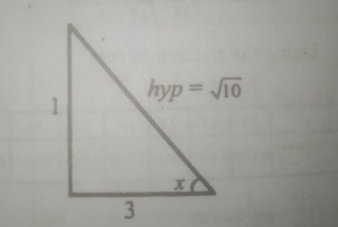If tan x = \(\frac{1}{3}\), where 180º < x < 270º
evaluate \(\frac{sin2 x - cos x}{2 tan x + sin 2x}\), leaving the answer in surd form (radicals)

hyp\(^2\) = 3\(^2\) + 1\(^2\) (Pythagoras's theorem)
hyp = \(\sqrt{10}\)
Given: tan x = \(\frac{1}{3}\) ( sin and cos will be in the third quadrant and are both negative where 180º < x < 270º)
sin x = \(\frac{-1}{\sqrt{10}}\), cos x = \(\frac{-3}{\sqrt{10}}\)
\(\frac{sin2 x - cos x}{2 tan x + sin 2x}\) = \(\frac{2sinx cos x - cos x}{2 tan x + 2sin x cos x}\) but 2snx cox = \(\frac{3}{5}\)
\(\frac{sin2 x - cos x}{2 tan x + sin 2x}\) = \(\frac{\frac{3}{5} + \frac{3}{\sqrt{10}}}{2(\frac{1}{3}) + \frac{3}{5}}\) = \(\frac{\frac{3}{5} + \frac{3}{\sqrt{10}}}{\frac{19}{15}}\)
= (\(\frac{3}{5}\) + \(\frac{3\sqrt{10}}{10}\)) \(\div\) \(\frac{19}{15}\) = \(\frac{15}{19}\)[\(\frac{3}{5}\) + \(\frac{3}{\sqrt{10}}\)]
= \(\frac{9}{19}\) + \(\frac{45}{19\sqrt{10}}\)
= \(\frac{9}{19}\) + \(\frac{45 \sqrt{10}}{19(10)}\)
= \(\frac{9}{19}\) + \(\frac{9 \sqrt{10}}{19(2)}\)
= \(\frac{9}{19}\)[1 + \(\frac{\sqrt{10}}{2}\)]
Contributions ({{ comment_count }})
Please wait...
Modal title
Report
Block User
{{ feedback_modal_data.title }}